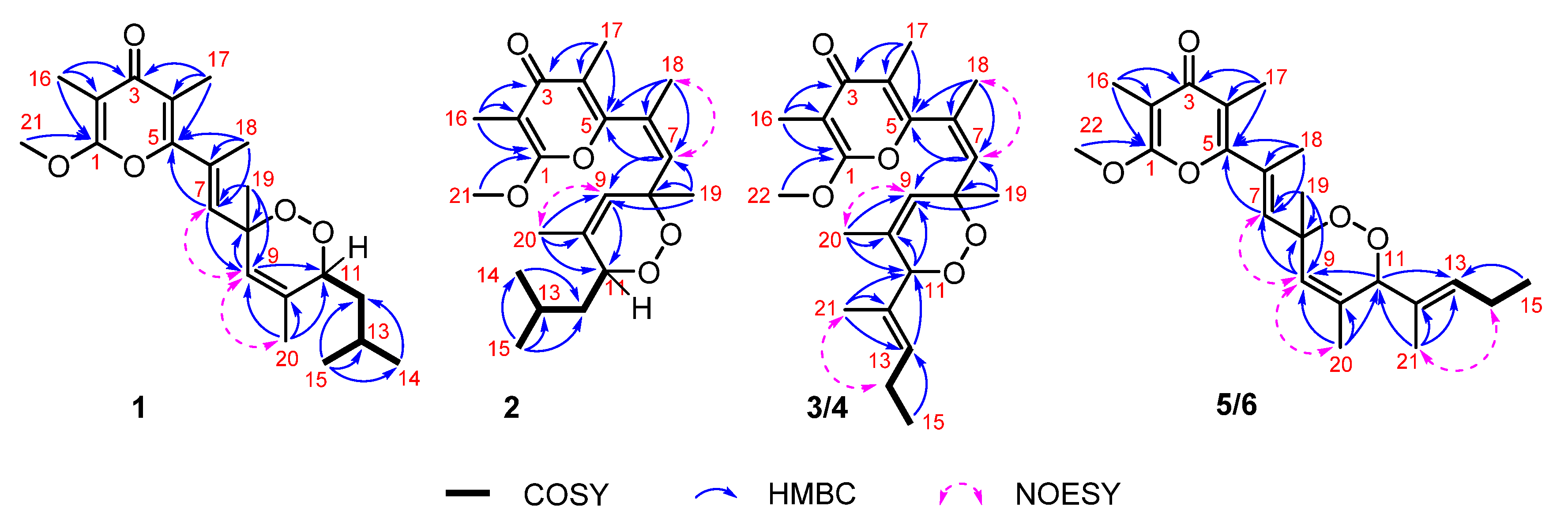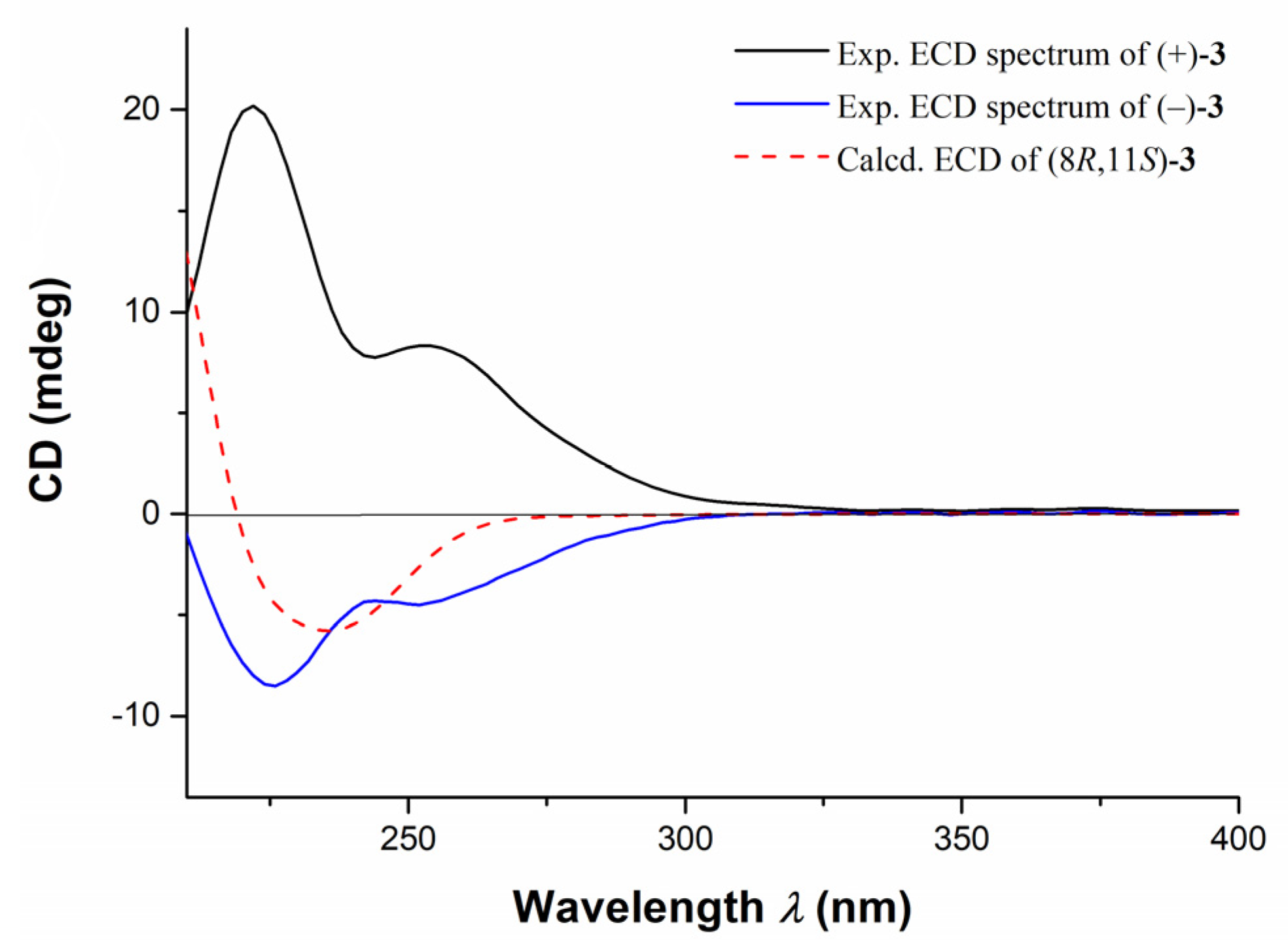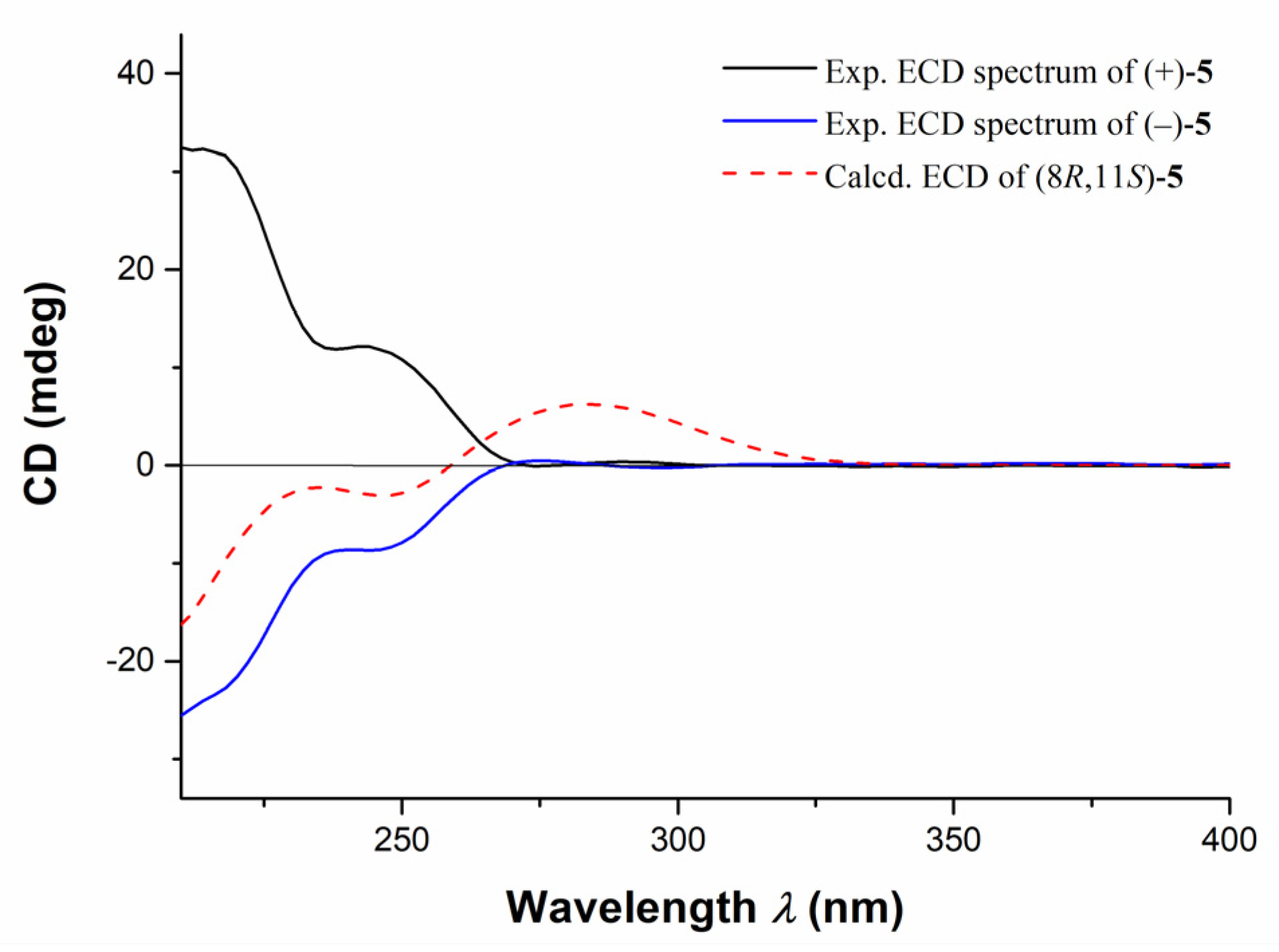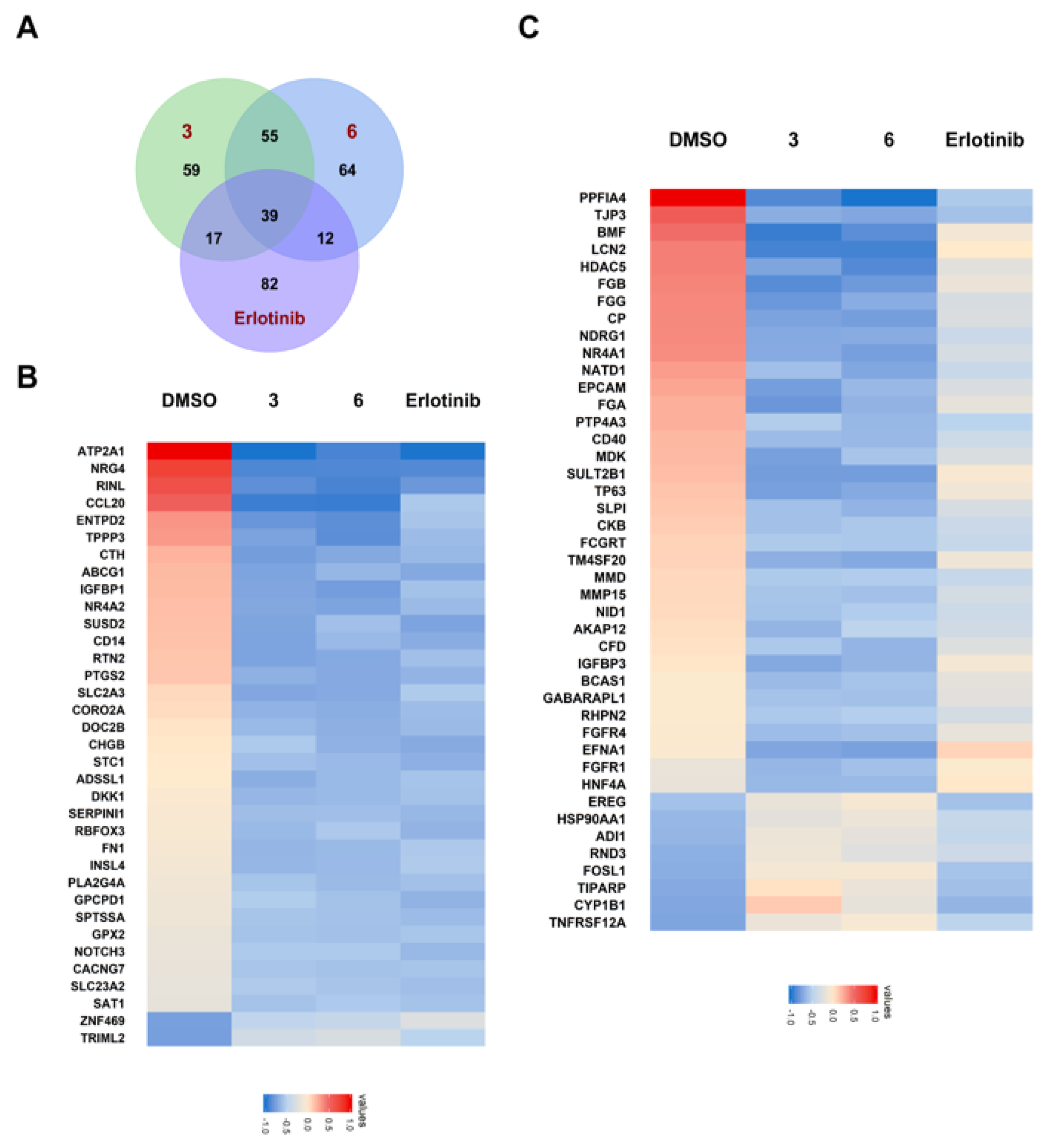Ocellatuperoxides A–F, Uncommon Anti-Tumoral γ-Pyrone Peroxides from a Photosynthetic Mollusk Placobranchus ocellatus
Abstract
:1. Introduction
2. Results and Discussion
2.1. Structural Elucidation of Ocellatuperoxides A–F (1–6)
2.2. Bioactivity Test of Ocellatuperoxides A–F (1–6)
3. Materials and Methods
3.1. General Experimental Procedures
3.2. Biological Material
3.3. Extraction and Isolation
3.4. Spectroscopic Data of Compounds
3.5. X-ray Crystallographic Analysis for Ocellatuperoxide A (1)
3.6. TDDFT-ECD Calculations
3.7. Cell Viability Assay
3.8. RNA-Seq Data Collection and Analysis
3.9. RNA Extraction and Quantitative RT-qPCR
| Primers | Forward | Reverse |
| FGFR1 | CCCGTAGCTCCATATTGGACA | TTTGCCATTTTTCAACCAGCG |
| FGFR4 | GAGGGGCCGCCTAGAGATT | CAGGACGATCATGGAGCCT |
| HDAC5 | TCTTGTCGAAGTCAAAGGAGC | GAGGGGAACTCTGGTCCAAAG |
| MDK | AGTCGCCTCTTAGCGGATG | GCCGCCCTTCTTCACCTTAT |
| GAPDH | GAAGGTCGGAGTCAACGGAT | CCTGGAAGATGGTGATGGG |
4. Conclusions
Supplementary Materials
Author Contributions
Funding
Institutional Review Board Statement
Data Availability Statement
Acknowledgments
Conflicts of Interest
References
- References Bornancin, L.; Bonnard, I.; Mills, S.C.; Banaigs, B. Chemical mediation as a structuring element in marine gastropod predator-prey interactions. Nat. Prod. Rep. 2017, 34, 644–676. [Google Scholar] [CrossRef] [PubMed]
- Davies-Coleman, M.T.; Garson, M.J. Marine polypropionates. Nat. Prod. Rep. 1998, 15, 477–493. [Google Scholar] [CrossRef] [PubMed]
- Liu, Z.-M.; Liu, H.-X.; Zhang, W.-M. Natural polypropionates in 1999–2020: An overview of chemical and biological diversity. Mar. Drugs 2020, 18, 569. [Google Scholar] [CrossRef] [PubMed]
- Gavagnin, M.; Marin, A.; Mollo, E.; Crispino, A.; Villani, G.; Cimino, G. Secondary metabolites from Mediterranean Elysioidea: Origin and biological role. Comp. Biochem. Physiol. B 1994, 108, 107–115. [Google Scholar] [CrossRef]
- Ireland, C.; Scheuer, P.J. Photosynthetic marine mollusks: In vivo 14C incorporation into metabolites of the sacoglossan Placobranchus ocellatus. Science 1979, 205, 922–923. [Google Scholar] [CrossRef] [PubMed]
- Manzo, E.; Ciavatta, M.L.; Gavagnin, M.; Mollo, E.; Wahidulla, S.; Cimino, G. New g-pyrone propionates from the Indian Ocean sacoglossan Placobranchus ocellatus. Tetrahedron Lett. 2005, 46, 465–468. [Google Scholar] [CrossRef]
- Zuidema, D.R.; Jones, P.B. Photochemical relationships in Sacoglossan polypropionates. J. Nat. Prod. 2005, 68, 481–486. [Google Scholar] [CrossRef] [PubMed]
- Faulkner, D.J. Marine natural products. Nat. Prod. Rep. 2000, 17, 7–55. [Google Scholar] [CrossRef] [PubMed]
- Carbone, M.; Ciavatta, M.L.; Wang, J.-R.; Cirillo, I.; Mathieu, V.; Kiss, R.; Mollo, E.; Guo, Y.-W.; Gavagnin, M. Extending the record of bis-g-pyrone polypropionates from marine pulmonated mollusks. J. Nat. Prod. 2013, 76, 2065–2073. [Google Scholar] [CrossRef] [PubMed]
- Rodriguez, J.; Riguera, R.; Debitus, C. The natural polypropionate-derived esters of the mollusk Onchidium sp. J. Org. Chem. 1992, 57, 4624–4632. [Google Scholar] [CrossRef]
- Rodriguez, J.; Riguera, R.; Debitus, C. New marine cytotoxic bispyrones. Absolute stereochemistry of onchitriols I and II. Tetrahedron Lett. 1992, 33, 1089–1092. [Google Scholar] [CrossRef]
- Zhou, Z.-F.; Li, X.-L.; Yao, L.-G.; Li, J.; Gavagnin, M.; Guo, Y.-W. Marine bis- g -pyrone polypropionates of onchidione family and their effects on the XBP1 gene expression. Bioorg. Med. Chem. Lett. 2018, 28, 1093–1096. [Google Scholar] [CrossRef] [PubMed]
- Wu, Q.-H.; Li, S.-W.; Xu, H.; Hu, P.; Zhang, H.; Luo, C.; Chen, K.-X.; Wang, H.; Guo, Y.-W.; Nay, B.; et al. Complex Polypropionates from a South China Sea Photosynthetic Mollusk: Isolation and Biomimetic Synthesis Highlighting Novel Rearrangements. Angew. Chem. Int. Ed. 2020, 59, 12105–12112. [Google Scholar] [CrossRef] [PubMed]
- Adele, C.; Angelo, F.; Licia, R.; Cimino, G. Placidenes C-F, novel α-pyrone propionates from the Mediterranean sacoglossan Placida dendritica. J. Nat. Prod. 2013, 66, 1399–1401. [Google Scholar] [CrossRef]
- Sun, L.-L.; Li, W.-S.; Li, J.; Zhang, H.-Y.; Yao, L.-G.; Luo, C.; Guo, Y.-W.; Li, X.-W. Uncommon Diterpenoids from the South China Sea Soft Coral Sinularia humilis and Their Stereochemistry. J. Org. Chem. 2021, 86, 3367–3376. [Google Scholar] [CrossRef] [PubMed]
- Desai, A.; Adjei, A.A. FGFR Signaling as a Target for Lung Cancer Therapy. J. Thorac. Oncol. 2016, 11, 9–20. [Google Scholar] [CrossRef] [PubMed]
- Gong, S.-K.; Ying, L.; Fan, Y.-N.; Sun, Z.-T. Fentanyl Inhibits Lung Cancer Viability and Invasion via Upregulation of miR-331-3p and Repression of HDAC5. OncoTargets Ther. 2020, 13, 13131–13141. [Google Scholar] [CrossRef] [PubMed]
- Dong, H.S.; Jeong, Y.J.; Sun, H.K.; Minyoung, C.; Chungyong, H.; Beom, K.C.; Sang, S.K. Midkine is a potential therapeutic target of tumorigenesis, angiogenesis, and metastasis in non-small cell lung cancer. Cancers 2020, 12, 2402. [Google Scholar] [CrossRef]









| No. | 1 | 2 | ||
|---|---|---|---|---|
| δH (Mult., J in Hz) | δC Mult. | δH (Mult., J in Hz) | δC Mult. | |
| 1 | - | 162.0, s | - | 163.0, s |
| 2 | - | 99.6, s | - | 100.4, s |
| 3 | - | 181.6, s | - | 180.7, s |
| 4 | - | 118.1, s | - | 118.7, s |
| 5 | - | 158.5, s | - | 156.2, s |
| 6 | - | 129.0, s | - | 128.3, s |
| 7 | 5.80 (s) | 138.9, d | 5.83 (s) | 137.2, d |
| 8 | - | 79.8, s | - | 79.4, s |
| 9 | 5.67 (s) | 125.5, d | 5.27 (s) | 124.2, d |
| 10 | - | 134.5, s | - | 134.5, s |
| 11 | 4.45 (d, 9.4) | 79.3, d | 4.34 (br s) | 79.2, d |
| 12 | 1.54 (m) 1.30 (m) | 39.5, t | 1.30 (m) 1.30 (m) | 39.4, t |
| 13 | 1.45 (m) | 24.7, d | 1.76 (m) | 24.8, d |
| 14 | 0.94 (d, 6.6) | 21.9, q | 0.90 (d, 6.6) | 21.6, q |
| 15 | 0.93 (d, 6.6) | 23.9, q | 0.90 (d, 6.6) | 23.8, q |
| 16 | 1.86 (s) | 7.0, q | 1.91 (s) | 7.3, q |
| 17 | 1.98 (s) | 11.9, q | 1.89 (s) | 11.3, q |
| 18 | 2.05 (s) | 16.0, q | 1.96 (s) | 23.8, q |
| 19 | 1.45 (s) | 24.7, q | 1.26 (s) | 24.8, q |
| 20 | 1.73 (s) | 18.5, q | 1.54 (s) | 18.3, q |
| 21 | 3.95 (s) | 55.4, q | 3.96 (s) | 55.9, q |
| No. | 3 | 4 | 5 | 6 | ||||
|---|---|---|---|---|---|---|---|---|
| δH (Mult., J in Hz) | δC Mult. | δH (Mult., J in Hz) | δC mult. | δH (Mult., J in Hz) | δC Mult. | δH (Mult., J in Hz) | δC Mult. | |
| 1 | - | 162.5, s | - | 162.7, s | - | 162.1, s | - | 162.1, s |
| 2 | - | 100.6, s | - | 100.4, s | - | 99.6, s | - | 99.6, s |
| 3 | - | 180.9, s | - | 181.1, s | - | 181.7, s | - | 181.6, s |
| 4 | - | 119.2, s | - | 119.0, s | - | 117.9, s | - | 118.1, s |
| 5 | - | 155.4, s | - | 155.4, s | - | 158.7, s | - | 158.3, s |
| 6 | - | 130.4, s | - | 126.6, s | - | 127.4, s | - | 130.5, s |
| 7 | 5.77 (s) | 136.2, d | 6.09 (s) | 138.6, d | 5.91 (s) | 139.8, d | 5.72 (s) | 137.6, d |
| 8 | - | 78.7, s | - | 79.4, s | - | 79.9, s | - | 79.5, s |
| 9 | 5.38 (s) | 125.3, d | 5.44 (s) | 126.2, d | 5.85 (s) | 126.8, d | 5.77 (s) | 126.8, d |
| 10 | - | 132.3, s | - | 132.7, s | - | 133.1, s | - | 132.4, s |
| 11 | 4.33 (s) | 86.9, d | 4.75 (s) | 87.4, d | 4.85 (s) | 87.5, d | 4.64 (s) | 86.2, d |
| 12 | - | 130.4, s | - | 128.9, s | - | 129.0, s | - | 129.8, s |
| 13 | 5.38 (ov) | 135.6, d | 5.60 (t, 7.2) | 137.3, d | 5.63 (t, 7.2) | 137.4, d | 5.54 (t, 7.4) | 136.2, d |
| 14 | 2.05 (m) 2.05 (m) | 21.4, t | 2.06 (m) 2.06 (m) | 21.4, t | 2.06 (m) 2.06 (m) | 21.4, t | 2.10 (m) 2.10 (m) | 21.4, t |
| 15 | 0.95 (t, 7.5) | 13.9, q | 0.97 (t, 7.5) | 13.8, q | 0.98 (t, 7.5) | 13.8, q | 0.99 (t, 7.5) | 13.9, q |
| 16 | 1.87 (s) | 7.0, q | 1.89 (s) | 7.1, q | 1.85 (s) | 7.0, q | 1.85 (s) | 7.0, q |
| 17 | 1.87 (s) | 11.0, q | 1.89 (s) | 11.7, q | 1.98 (s) | 11.8, q | 1.98 (s) | 12.0, q |
| 18 | 1.96 (s) | 23.7, q | 1.95 (s) | 23.6, q | 2.08 (s) | 15.9, q | 2.06 (s) | 16.1, q |
| 19 | 1.31 (s) | 25.0, q | 1.17 (s) | 23.9, q | 1.38 (s) | 24.1, q | 1.52 (s) | 25.3, q |
| 20 | 1.41 (s) | 18.8, q | 1.49 (s) | 18.0, q | 1.63 (s) | 18.1, q | 1.65 (s) | 18.7, q |
| 21 | 1.56 (s) | 13.0, q | 1.47 (s) | 11.6, q | 1.45 (s) | 11.5, q | 1.63 (s) | 12.8, q |
| 22 | 3.95 (s) | 55.7, q | 3.92 (s) | 55.7, q | 3.94 (s) | 55.7, q | 3.95 (s) | 55.5, q |
| No. | IC50 (μM) a | ||
|---|---|---|---|
| NB4 | A549 | HepG2 | |
| 3 | 11.1 ± 1.7 | 7.8 ± 0.8 | 8.7 ± 0.7 |
| 4 | 16.3 ± 1.0 | 18.4 ± 0.2 | – |
| 5 | – | 14.2 ± 0.3 | – |
| 6 | – | 11.7 ± 0.6 | – |
| Gefitinib b | 8.4 ± 0.2 | 7.4 ± 0.8 | 8.2 ± 0.1 |
| Erlotinib b | 17.2 ± 3.8 | 2.1 ± 0.2 | 6.9 ± 2.2 |
Publisher’s Note: MDPI stays neutral with regard to jurisdictional claims in published maps and institutional affiliations. |
© 2022 by the authors. Licensee MDPI, Basel, Switzerland. This article is an open access article distributed under the terms and conditions of the Creative Commons Attribution (CC BY) license (https://creativecommons.org/licenses/by/4.0/).
Share and Cite
Li, S.-W.; Wu, Q.; Xu, H.; Yao, L.-G.; Luo, C.; Wang, H.; Zhang, H.; Li, X.-W.; Guo, Y.-W. Ocellatuperoxides A–F, Uncommon Anti-Tumoral γ-Pyrone Peroxides from a Photosynthetic Mollusk Placobranchus ocellatus. Mar. Drugs 2022, 20, 590. https://doi.org/10.3390/md20100590
Li S-W, Wu Q, Xu H, Yao L-G, Luo C, Wang H, Zhang H, Li X-W, Guo Y-W. Ocellatuperoxides A–F, Uncommon Anti-Tumoral γ-Pyrone Peroxides from a Photosynthetic Mollusk Placobranchus ocellatus. Marine Drugs. 2022; 20(10):590. https://doi.org/10.3390/md20100590
Chicago/Turabian StyleLi, Song-Wei, Qihao Wu, Heng Xu, Li-Gong Yao, Cheng Luo, Hong Wang, Hao Zhang, Xu-Wen Li, and Yue-Wei Guo. 2022. "Ocellatuperoxides A–F, Uncommon Anti-Tumoral γ-Pyrone Peroxides from a Photosynthetic Mollusk Placobranchus ocellatus" Marine Drugs 20, no. 10: 590. https://doi.org/10.3390/md20100590





